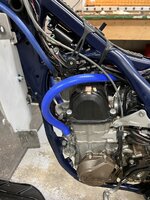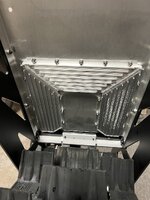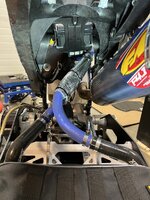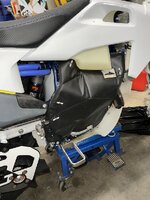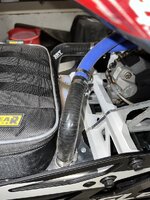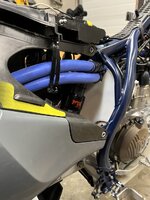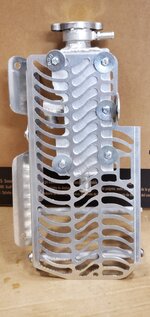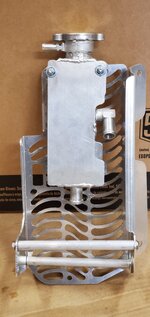Sounds like this is the thread to be on. I'd worked through a bit of this on the thread https://www.snowest.com/forum/threads/yeti-tunnel-cooler.454418/page-2 and so reached out to Dave/XRT. He whipped up a coolant bottle for me with the site and angle fittings and neck angle I wanted. Received the bottle last week and will soon tackle my coolant system revamp.
Backstory: End of 2019, I built my third snowbike since 2013. This build was a 2020 YZ450F and 2020 Yeti 129. I wanted to do a tunnel cooler on the build which is part of what had me trying a Yeti (previous two rigs were KTM/Timbersled, Husaberg 501/CMX 129). When the 2020 Yeti hit the ground, everyone said the C3 tunnel coolers would no longer work due to the new aluminum bracing on the Yeti so I did the build without a tunnelcooler. Then, many people were successful installing the C3 tunnel cooler and simply drilled through the extra aluminum with no issue. Fast forward through 3 season; each of which had me, on certain points on nearly every ride, wishing for a tunnel cooler. This is the year. I ordered the tunnel cooler and associated parts this fall and started evaluating coolant bottle solutions so I could decide if I was going to do a radiator delete. In the other thread (linked above), Dr.Z mentioned the XRT solution. A few emails later and my custom coolant bottle was in the mail.
I run a Selkirk engine shroud and have a bib that I made to cover and uncover the radiators (it covers everything from the Selkirk engine cover all the way up and wraps back towards the intake cover (think gas tank on Non-Yamaha bikes); so full coverage. It really is like a bib that goes around my bikes "neck" so does a really good job blocking all snow/cold including any that would enter from the top. Foam insert between the frame rails under the motor held in by Selkirk skidplate. Same foam around rear if engine. I have the Selkirk heat exchanger plumped on the thermostat-open circuit. (Selkirk always recommended it go on the bypass circuit, but only wanted it on the thermostat-open circuit). This setup works quite well, though I do still have to put the radiator bib off and on; Off for the trail ride in and then on (most of the time) when we reach the pow. Selkirk heat exchange and coolant-heated bars are plenty most of the time with occasionally needing to uncover the top part of the radiators depending on snow conditions. Running a C3 90C/194F thermostat, C3 intake, etc. Main issues with getting hot is when doing long, WOT but slow over-the-ground speed, uphill pulls in deep pow. Also in spring snow when riding slow (not enough air over the uncovered radiators). I also ran Evans waterless coolant last season and found that I now prefer it over typical coolant as I don't boil over if temps get away from me on a long pull. I'll run it again in the revamped system.
For this cooling system revamp, I'll pull out the Selkirk heat exchanger and related plumbing, but keep the Selkirk engine surround which I love. I am removing the Bulletproof brand radiator guards and replacing with Unabiker since they will better support the XRT coolant bottle and the bikes plastic shrouds. C3 sold me a smaller diameter thermostat nipple for my existing C3 thermostat. The stock Yamaha hose is a very large diameter that feeds the radiators. The tunnel cooler lines are 5/8". This smaller thermostat nipple will let me stretch a 5/8" silicone coolant hose over it, run directly back to the tunnel cooler, then forward to XRT coolant bottle which will be mounted to the Unabiker radiator guards (with no radiators). Dave put a 5/8" coolant bottle return line nipple and angled it back 45degrees for me. So 5/8" tunnel cooler return line goes in the side of coolant bottle then 5/8" out the bottom of the coolant bottle and into one leg of my stock Y collector going into the water pump. I currently have a C3 hose on the other leg of that Y collector that combines a line from the left radiator and heated handlebars. C3 sold me a new fitting to replace that; a simple stubbed silicone hose with only one adapter on it; for the C3 handlebars inlet.
So in short, my thermostat bypass circuit will come off the thermostat, through the heated bars, into one leg of the waterpump Y collector. The thermostat-open leg will come out of thermostat, back to tunnel cooler, forward to the XRT coolant bottle, then down to the other leg of the waterpump Y collector. Will really clean things up compared to the current Selkirk heat exchanger, heated bar, and radiator setup. I plan to run the bib fulltime now, but will have the option to remove it if I ever get into a situation (boiler plate trail on the way in in the spring) where tunnel cooler isn't getting enough snowdust. Removing the bib will let air hit not only the coolant bottle, but all that air will push into the engine bay and out the side. Not like having radiators, but will be at least an option to get a tiny bit more cooling in those rare trail situations where the tunnel cooler will struggle. I'll be thinking through a scratcher solution as well (rails? Or more likely, on the rear pf the ski).
Build pictures to come in the next few weeks (in this or a separate thread).
Backstory: End of 2019, I built my third snowbike since 2013. This build was a 2020 YZ450F and 2020 Yeti 129. I wanted to do a tunnel cooler on the build which is part of what had me trying a Yeti (previous two rigs were KTM/Timbersled, Husaberg 501/CMX 129). When the 2020 Yeti hit the ground, everyone said the C3 tunnel coolers would no longer work due to the new aluminum bracing on the Yeti so I did the build without a tunnelcooler. Then, many people were successful installing the C3 tunnel cooler and simply drilled through the extra aluminum with no issue. Fast forward through 3 season; each of which had me, on certain points on nearly every ride, wishing for a tunnel cooler. This is the year. I ordered the tunnel cooler and associated parts this fall and started evaluating coolant bottle solutions so I could decide if I was going to do a radiator delete. In the other thread (linked above), Dr.Z mentioned the XRT solution. A few emails later and my custom coolant bottle was in the mail.
I run a Selkirk engine shroud and have a bib that I made to cover and uncover the radiators (it covers everything from the Selkirk engine cover all the way up and wraps back towards the intake cover (think gas tank on Non-Yamaha bikes); so full coverage. It really is like a bib that goes around my bikes "neck" so does a really good job blocking all snow/cold including any that would enter from the top. Foam insert between the frame rails under the motor held in by Selkirk skidplate. Same foam around rear if engine. I have the Selkirk heat exchanger plumped on the thermostat-open circuit. (Selkirk always recommended it go on the bypass circuit, but only wanted it on the thermostat-open circuit). This setup works quite well, though I do still have to put the radiator bib off and on; Off for the trail ride in and then on (most of the time) when we reach the pow. Selkirk heat exchange and coolant-heated bars are plenty most of the time with occasionally needing to uncover the top part of the radiators depending on snow conditions. Running a C3 90C/194F thermostat, C3 intake, etc. Main issues with getting hot is when doing long, WOT but slow over-the-ground speed, uphill pulls in deep pow. Also in spring snow when riding slow (not enough air over the uncovered radiators). I also ran Evans waterless coolant last season and found that I now prefer it over typical coolant as I don't boil over if temps get away from me on a long pull. I'll run it again in the revamped system.
For this cooling system revamp, I'll pull out the Selkirk heat exchanger and related plumbing, but keep the Selkirk engine surround which I love. I am removing the Bulletproof brand radiator guards and replacing with Unabiker since they will better support the XRT coolant bottle and the bikes plastic shrouds. C3 sold me a smaller diameter thermostat nipple for my existing C3 thermostat. The stock Yamaha hose is a very large diameter that feeds the radiators. The tunnel cooler lines are 5/8". This smaller thermostat nipple will let me stretch a 5/8" silicone coolant hose over it, run directly back to the tunnel cooler, then forward to XRT coolant bottle which will be mounted to the Unabiker radiator guards (with no radiators). Dave put a 5/8" coolant bottle return line nipple and angled it back 45degrees for me. So 5/8" tunnel cooler return line goes in the side of coolant bottle then 5/8" out the bottom of the coolant bottle and into one leg of my stock Y collector going into the water pump. I currently have a C3 hose on the other leg of that Y collector that combines a line from the left radiator and heated handlebars. C3 sold me a new fitting to replace that; a simple stubbed silicone hose with only one adapter on it; for the C3 handlebars inlet.
So in short, my thermostat bypass circuit will come off the thermostat, through the heated bars, into one leg of the waterpump Y collector. The thermostat-open leg will come out of thermostat, back to tunnel cooler, forward to the XRT coolant bottle, then down to the other leg of the waterpump Y collector. Will really clean things up compared to the current Selkirk heat exchanger, heated bar, and radiator setup. I plan to run the bib fulltime now, but will have the option to remove it if I ever get into a situation (boiler plate trail on the way in in the spring) where tunnel cooler isn't getting enough snowdust. Removing the bib will let air hit not only the coolant bottle, but all that air will push into the engine bay and out the side. Not like having radiators, but will be at least an option to get a tiny bit more cooling in those rare trail situations where the tunnel cooler will struggle. I'll be thinking through a scratcher solution as well (rails? Or more likely, on the rear pf the ski).
Build pictures to come in the next few weeks (in this or a separate thread).
Last edited:




